GMC YUKON XL 2007 Workshop Manual
Manufacturer: GMC, Model Year: 2007, Model line: YUKON XL, Model: GMC YUKON XL 2007Pages: 608, PDF Size: 3.01 MB
Page 51 of 608
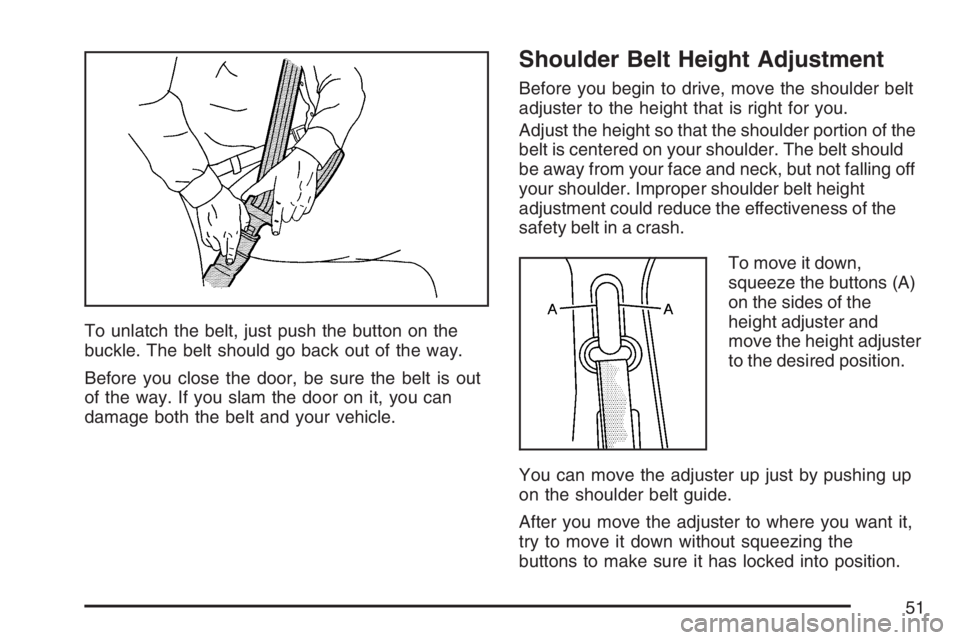
To unlatch the belt, just push the button on the
buckle. The belt should go back out of the way.
Before you close the door, be sure the belt is out
of the way. If you slam the door on it, you can
damage both the belt and your vehicle.
Shoulder Belt Height Adjustment
Before you begin to drive, move the shoulder belt
adjuster to the height that is right for you.
Adjust the height so that the shoulder portion of the
belt is centered on your shoulder. The belt should
be away from your face and neck, but not falling off
your shoulder. Improper shoulder belt height
adjustment could reduce the effectiveness of the
safety belt in a crash.
To move it down,
squeeze the buttons (A)
on the sides of the
height adjuster and
move the height adjuster
to the desired position.
You can move the adjuster up just by pushing up
on the shoulder belt guide.
After you move the adjuster to where you want it,
try to move it down without squeezing the
buttons to make sure it has locked into position.
51
Page 52 of 608
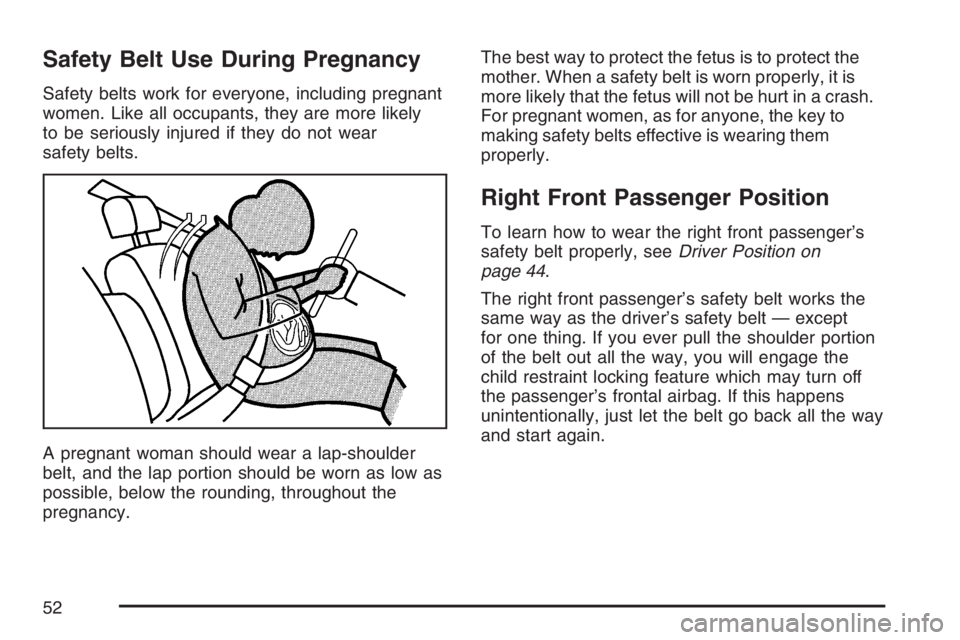
Safety Belt Use During Pregnancy
Safety belts work for everyone, including pregnant
women. Like all occupants, they are more likely
to be seriously injured if they do not wear
safety belts.
A pregnant woman should wear a lap-shoulder
belt, and the lap portion should be worn as low as
possible, below the rounding, throughout the
pregnancy.The best way to protect the fetus is to protect the
mother. When a safety belt is worn properly, it is
more likely that the fetus will not be hurt in a crash.
For pregnant women, as for anyone, the key to
making safety belts effective is wearing them
properly.
Right Front Passenger Position
To learn how to wear the right front passenger’s
safety belt properly, seeDriver Position on
page 44.
The right front passenger’s safety belt works the
same way as the driver’s safety belt — except
for one thing. If you ever pull the shoulder portion
of the belt out all the way, you will engage the
child restraint locking feature which may turn off
the passenger’s frontal airbag. If this happens
unintentionally, just let the belt go back all the way
and start again.
52
Page 53 of 608
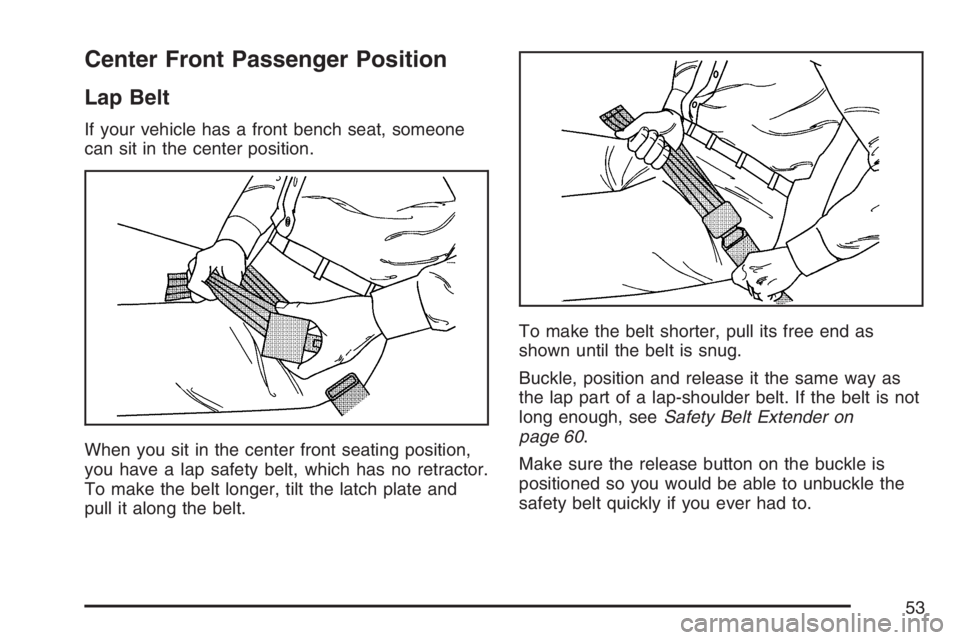
Center Front Passenger Position
Lap Belt
If your vehicle has a front bench seat, someone
can sit in the center position.
When you sit in the center front seating position,
you have a lap safety belt, which has no retractor.
To make the belt longer, tilt the latch plate and
pull it along the belt.To make the belt shorter, pull its free end as
shown until the belt is snug.
Buckle, position and release it the same way as
the lap part of a lap-shoulder belt. If the belt is not
long enough, seeSafety Belt Extender on
page 60.
Make sure the release button on the buckle is
positioned so you would be able to unbuckle the
safety belt quickly if you ever had to.
53
Page 54 of 608
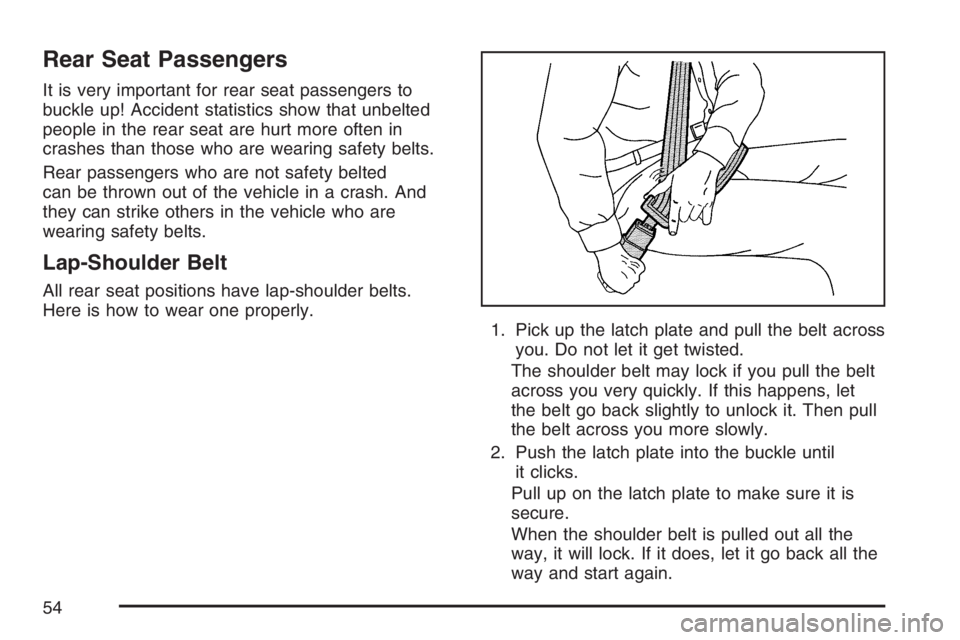
Rear Seat Passengers
It is very important for rear seat passengers to
buckle up! Accident statistics show that unbelted
people in the rear seat are hurt more often in
crashes than those who are wearing safety belts.
Rear passengers who are not safety belted
can be thrown out of the vehicle in a crash. And
they can strike others in the vehicle who are
wearing safety belts.
Lap-Shoulder Belt
All rear seat positions have lap-shoulder belts.
Here is how to wear one properly.
1. Pick up the latch plate and pull the belt across
you. Do not let it get twisted.
The shoulder belt may lock if you pull the belt
across you very quickly. If this happens, let
the belt go back slightly to unlock it. Then pull
the belt across you more slowly.
2. Push the latch plate into the buckle until
it clicks.
Pull up on the latch plate to make sure it is
secure.
When the shoulder belt is pulled out all the
way, it will lock. If it does, let it go back all the
way and start again.
54
Page 55 of 608
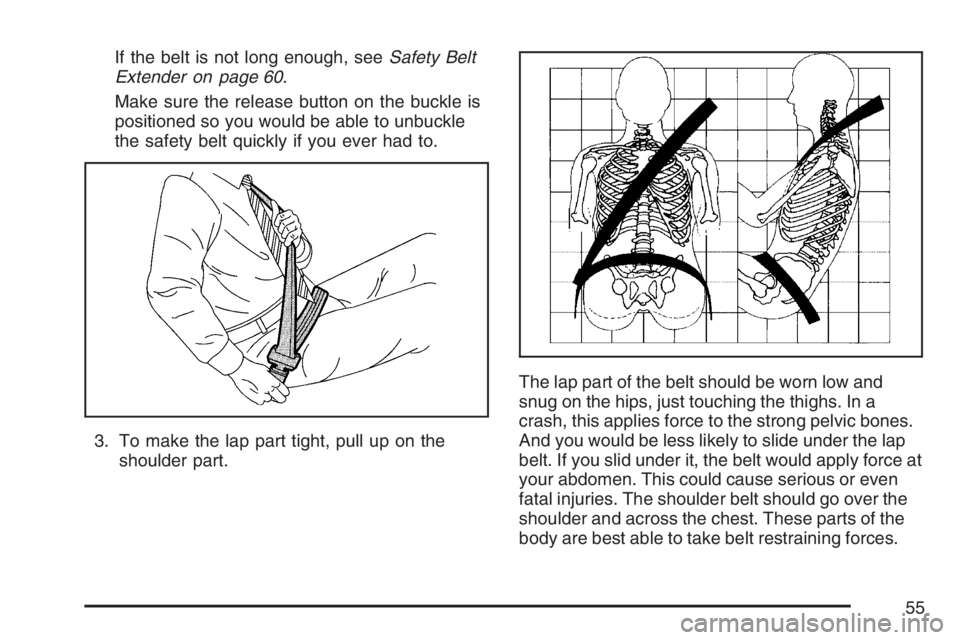
If the belt is not long enough, seeSafety Belt
Extender on page 60.
Make sure the release button on the buckle is
positioned so you would be able to unbuckle
the safety belt quickly if you ever had to.
3. To make the lap part tight, pull up on the
shoulder part.The lap part of the belt should be worn low and
snug on the hips, just touching the thighs. In a
crash, this applies force to the strong pelvic bones.
And you would be less likely to slide under the lap
belt. If you slid under it, the belt would apply force at
your abdomen. This could cause serious or even
fatal injuries. The shoulder belt should go over the
shoulder and across the chest. These parts of the
body are best able to take belt restraining forces.
55
Page 56 of 608
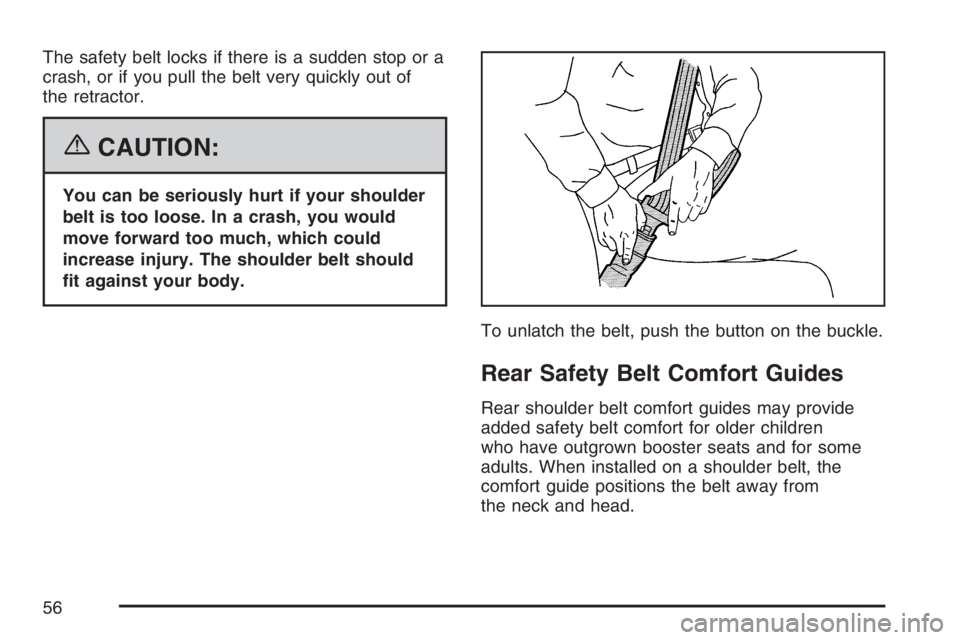
The safety belt locks if there is a sudden stop or a
crash, or if you pull the belt very quickly out of
the retractor.
{CAUTION:
You can be seriously hurt if your shoulder
belt is too loose. In a crash, you would
move forward too much, which could
increase injury. The shoulder belt should
�t against your body.
To unlatch the belt, push the button on the buckle.
Rear Safety Belt Comfort Guides
Rear shoulder belt comfort guides may provide
added safety belt comfort for older children
who have outgrown booster seats and for some
adults. When installed on a shoulder belt, the
comfort guide positions the belt away from
the neck and head.
56
Page 57 of 608
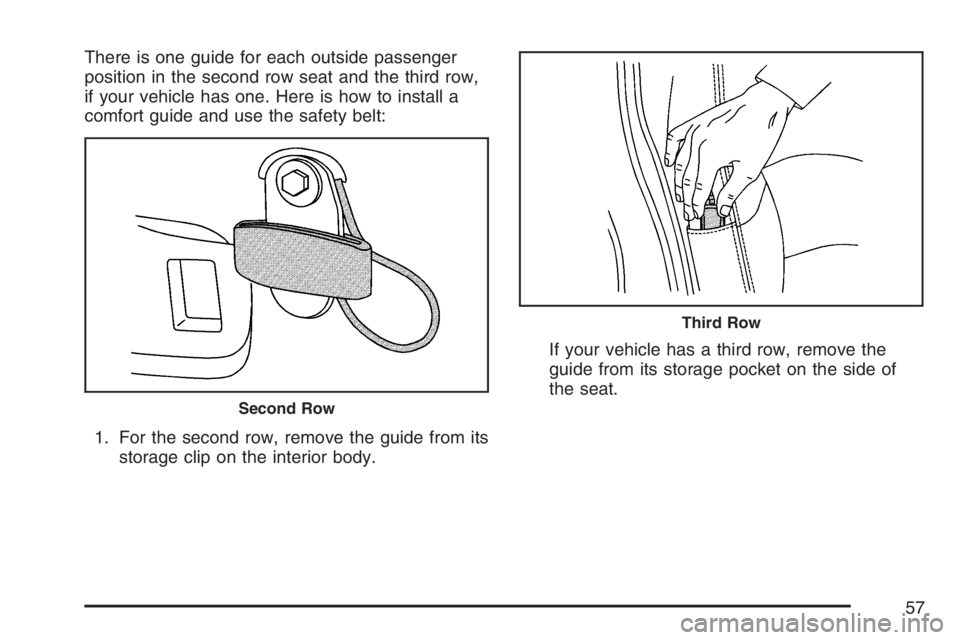
There is one guide for each outside passenger
position in the second row seat and the third row,
if your vehicle has one. Here is how to install a
comfort guide and use the safety belt:
1. For the second row, remove the guide from its
storage clip on the interior body.If your vehicle has a third row, remove the
guide from its storage pocket on the side of
the seat.
Second Row
Third Row
57
Page 58 of 608
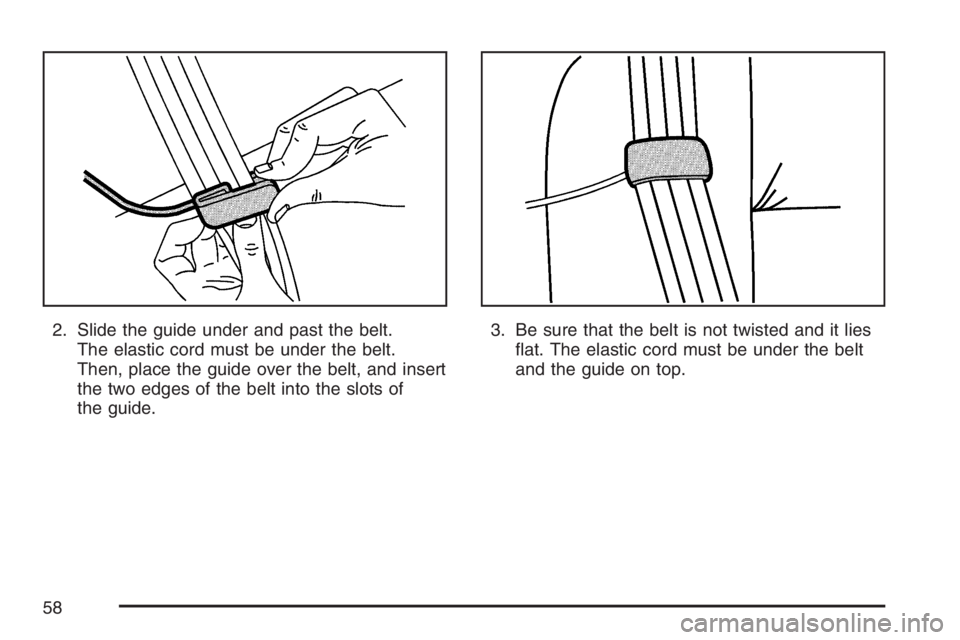
2. Slide the guide under and past the belt.
The elastic cord must be under the belt.
Then, place the guide over the belt, and insert
the two edges of the belt into the slots of
the guide.3. Be sure that the belt is not twisted and it lies
�at. The elastic cord must be under the belt
and the guide on top.
58
Page 59 of 608
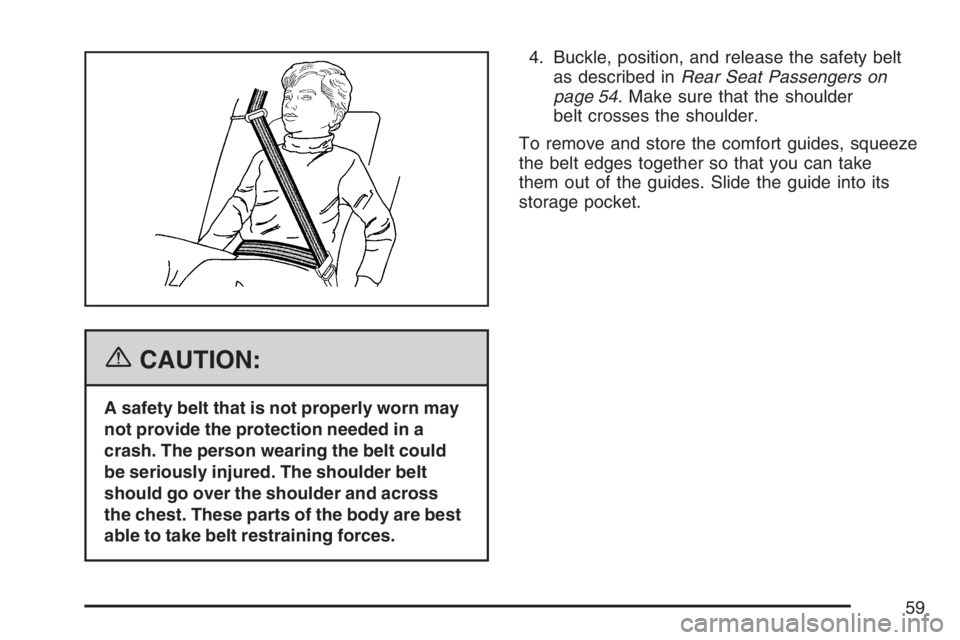
{CAUTION:
A safety belt that is not properly worn may
not provide the protection needed in a
crash. The person wearing the belt could
be seriously injured. The shoulder belt
should go over the shoulder and across
the chest. These parts of the body are best
able to take belt restraining forces.4. Buckle, position, and release the safety belt
as described inRear Seat Passengers on
page 54. Make sure that the shoulder
belt crosses the shoulder.
To remove and store the comfort guides, squeeze
the belt edges together so that you can take
them out of the guides. Slide the guide into its
storage pocket.
59
Page 60 of 608
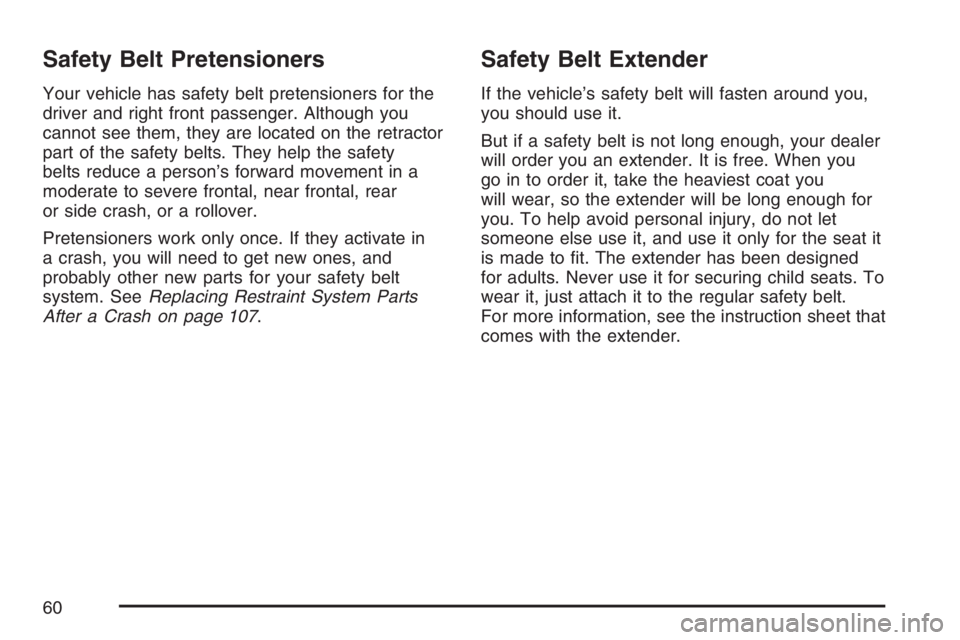
Safety Belt Pretensioners
Your vehicle has safety belt pretensioners for the
driver and right front passenger. Although you
cannot see them, they are located on the retractor
part of the safety belts. They help the safety
belts reduce a person’s forward movement in a
moderate to severe frontal, near frontal, rear
or side crash, or a rollover.
Pretensioners work only once. If they activate in
a crash, you will need to get new ones, and
probably other new parts for your safety belt
system. SeeReplacing Restraint System Parts
After a Crash on page 107.
Safety Belt Extender
If the vehicle’s safety belt will fasten around you,
you should use it.
But if a safety belt is not long enough, your dealer
will order you an extender. It is free. When you
go in to order it, take the heaviest coat you
will wear, so the extender will be long enough for
you. To help avoid personal injury, do not let
someone else use it, and use it only for the seat it
is made to �t. The extender has been designed
for adults. Never use it for securing child seats. To
wear it, just attach it to the regular safety belt.
For more information, see the instruction sheet that
comes with the extender.
60